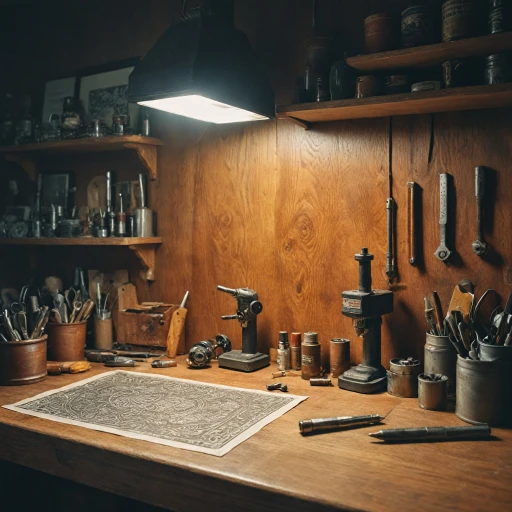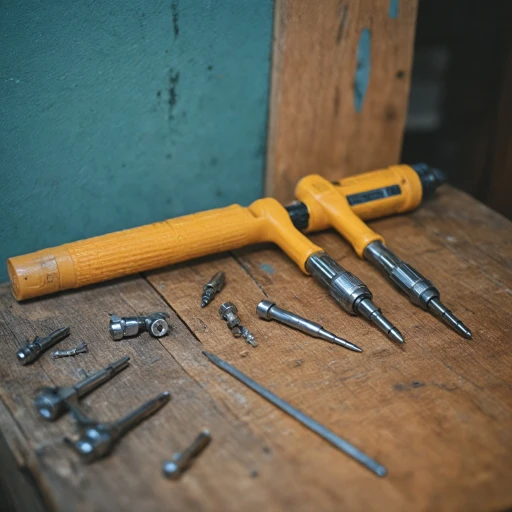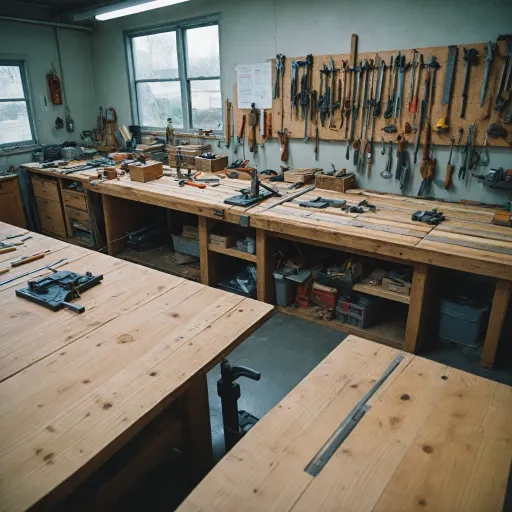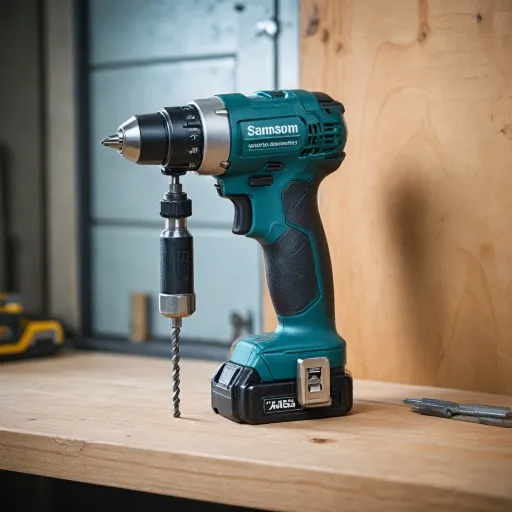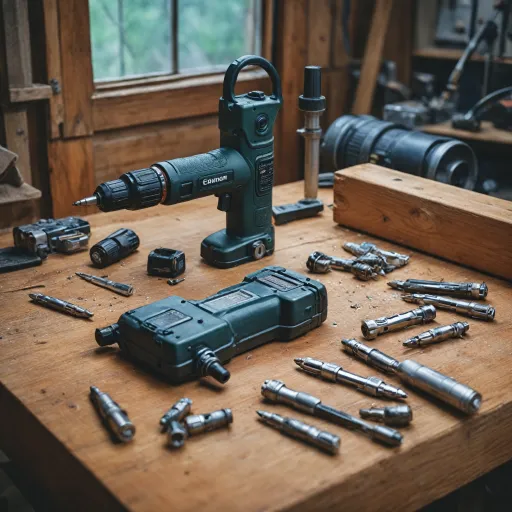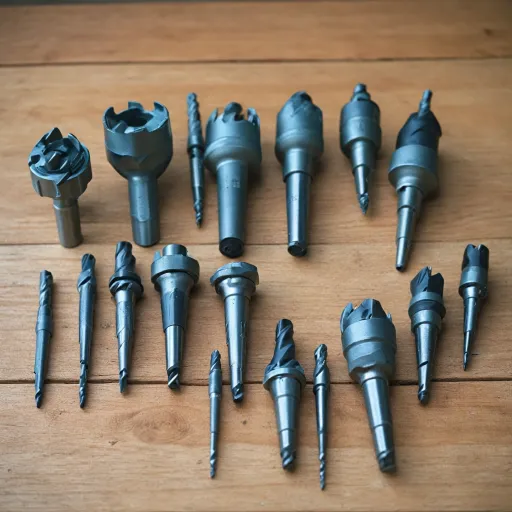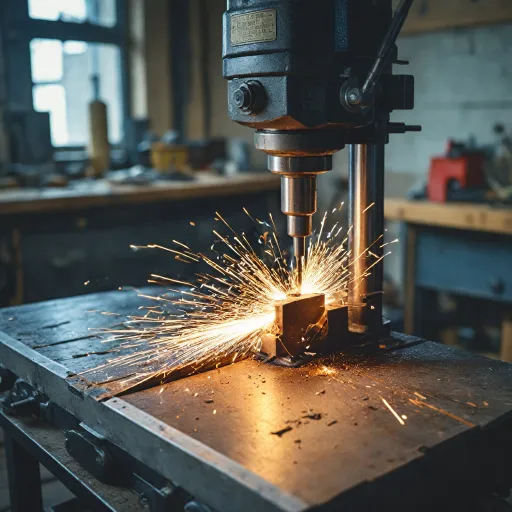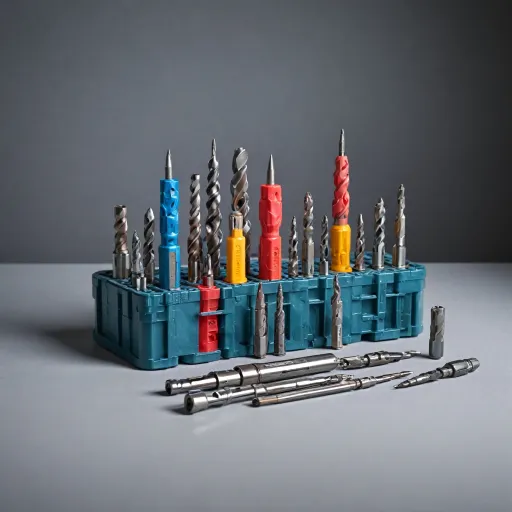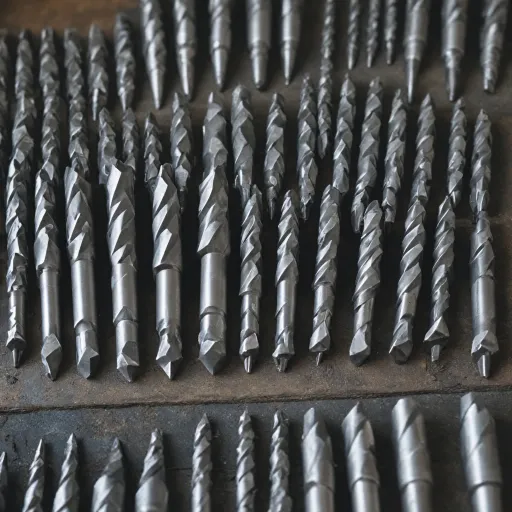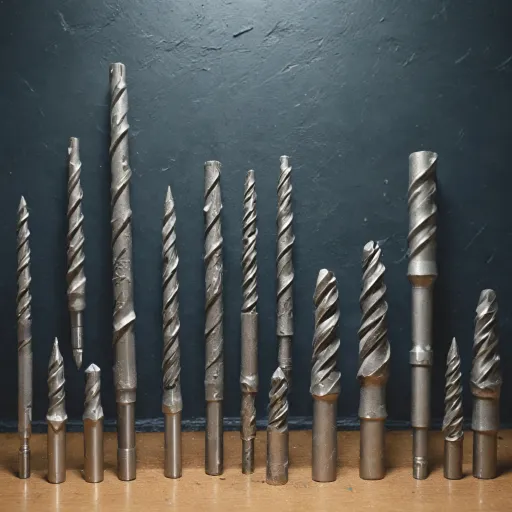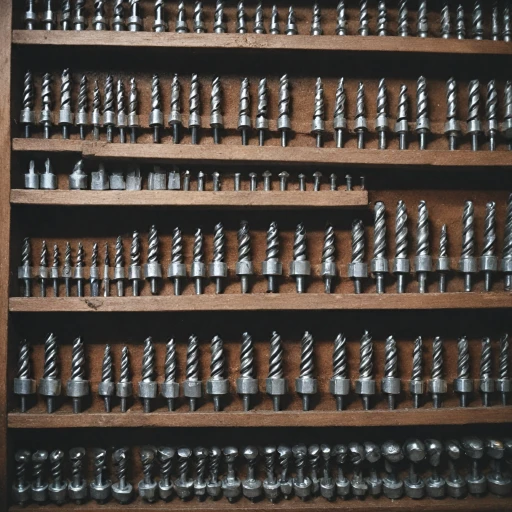
Understanding the challenges of drilling hardened steel
Why drilling into hardened steel is so tough
Drilling into hardened steel is a real challenge, even for experienced DIYers and professionals. The main reason is that hardened steel is specifically treated to be much tougher and more resistant than regular steel. This means standard drill bits, or even some high speed steel bits, can quickly become dull or even break. The hardness of the material puts extra stress on your drill, your bits, and your technique.
Hardened steel is used in products like automotive parts, tools, and security hardware. Its durability is great for performance, but makes it hard to cut or drill through. If you try to use a basic bit set, you’ll likely notice the bit just spins without making much progress, or worse, overheats and loses its edge. That’s why choosing the right drill bit is crucial for both safety and efficiency.
- Heat buildup: Drilling into hard steel generates a lot of heat. Without proper cooling, even the best drill bits can lose their sharpness quickly.
- Material hardness: Hardened steel is much harder than mild steel or cast iron, so it requires bits made from tougher materials like cobalt or carbide.
- Precision needed: If the bit slips or wanders, it can damage your workpiece or your drill. Using a split point or twist drill design can help with accuracy.
Many users also ask about the best drill bits for hardened steel and how to get the most out of their cordless drill set. The right combination of drill, bit, and technique can make a big difference in tool life and results. In the next sections, we’ll look at the features that matter most in drill bits for hard steel, and how to use your cordless drill set effectively for these tough jobs.
Key features to look for in drill bits for hardened steel
What Makes a Drill Bit Suitable for Hardened Steel?
When you’re working with hardened steel, not every drill bit will do the job. The material is tough and can quickly wear down standard bits. To get good results, you need to focus on several key features that set the best drill bits for hardened steel apart from regular options.
- Material Matters: Look for bits made from cobalt or carbide. Cobalt drill bits, often labeled as M35 or M42, are especially popular for hard steel and stainless steel. Carbide bits are even harder and last longer, but they come at a higher price. High speed steel (HSS) bits with a cobalt blend also work well for many jobs.
- Tip Design: A split point tip, usually at a 135-degree angle, helps the bit start cutting without wandering. This is crucial for accuracy and safety, especially on hard surfaces.
- Coating: Some steel bits have a titanium or black oxide coating. While these coatings can help with durability and reduce friction, cobalt and carbide bits are preferred for the hardest materials because the cutting edge itself is made from a hard alloy, not just coated.
- Sizes and Sets: A good bit set will include a range of sizes, so you can match the bit to your project. Check the product details to see if the set covers the sizes you need for your work.
- Cutting Performance: Sharpness is key. A sharp bit will cut cleanly and reduce heat build-up, which helps extend tool life. Using cutting oil can also make a big difference in performance and longevity.
When comparing products, consider the price versus durability. Cobalt bits may cost more upfront, but they often outlast standard high speed steel bits when drilling into hard steel or cast iron. Carbide bits are the top choice for repeated work on hardened metal, though they are more brittle and expensive.
For a deeper dive into how different drill bit sizes can impact your cordless drill set’s versatility, check out this guide on the versatility of a 3/8 drill bit in cordless drill sets.
Choosing the right drill bits for hardened steel is about balancing performance, price, and the specific needs of your project. The right bit set will help you work efficiently, keep your tools in good shape, and achieve a clean, precise cut every time.
Popular types of drill bits for hardened steel
Comparing the Most Effective Drill Bit Materials
When it comes to drilling into hardened steel, not all drill bits are created equal. The material and design of the bit play a huge role in how well it can cut through tough metals like hardened steel, stainless steel, or cast iron. Here’s a breakdown of the most popular types of drill bits you’ll find in a quality cordless drill set for this demanding job:
- Cobalt Drill Bits: These are a top choice for hardened steel. Cobalt bits are made from high speed steel (HSS) with 5-8% cobalt added. This makes them extremely hard and able to maintain their sharpness even at high temperatures. Cobalt bits work well for repeated drilling into hard steel and are known for their long tool life. They can be pricier than standard bits, but the investment pays off if you’re working with hardened metal regularly.
- Carbide Drill Bits: Carbide is even harder than cobalt, making these bits ideal for the toughest jobs. They are especially good for drilling into hardened steel, cast iron, and stainless steel. However, carbide bits are brittle and can break if not used carefully. They’re best for professional use or situations where other bits just won’t cut it.
- High Speed Steel (HSS) Bits: Standard HSS bits are affordable and work for softer metals, but they struggle with hardened steel. If you’re drilling mild steel or need a budget-friendly option, HSS is a good starting point, but for true hardened steel, cobalt or carbide is recommended.
Design Features That Make a Difference
Besides material, the design of the bit matters. Look for bits with a split point tip—this helps start the hole precisely and reduces wandering. Twist drill bits are the most common shape and work well for most metal drilling tasks. A sharp cutting edge is crucial, so always check the product details for information on sharpness and edge retention.
Bit Sets and Sizing Options
Many brands offer bit sets that include a range of sizes, which is useful if you work with different thicknesses of steel. Check the price and what’s included in the set—sometimes paying a bit more gets you better quality and a wider range of sizes. A good set will include both small and large bits, so you can tackle various projects.
Performance and Value
When comparing products, consider not just the price but also the expected tool life and how well the bits hold up under repeated use. Cobalt bits are often rated highly for their durability and performance in hard steel. Carbide bits, while expensive, are the best drill bits for extreme cases. Always use cutting oil to extend the life of your bits and improve cutting efficiency.
For more on drilling into challenging materials, check out this guide on mastering the art of drilling into tile with cordless drills.
How to use a cordless drill set effectively on hardened steel
Getting the Most from Your Cordless Drill Set on Hardened Steel
Using a cordless drill set on hardened steel can be challenging, but with the right approach and tools, you can achieve clean, precise holes and extend the life of your drill bits. Here’s how to make your work easier and more effective:- Choose the right drill bit: Not all bits are created equal. For hard steel, cobalt drill bits or carbide-tipped bits are recommended. These bits are designed to cut through tough materials like hardened steel, stainless steel, and cast iron. High speed steel (HSS) bits with a cobalt blend offer a good balance between price and durability.
- Use the correct speed: Drilling at a lower speed helps prevent overheating and preserves the sharpness of your bit. Most cordless drills allow you to adjust the speed. For hard metals, start slow and apply steady pressure.
- Apply cutting oil: Lubrication is essential when drilling hardened steel. Cutting oil reduces friction, keeps the bit cool, and extends tool life. It also helps produce cleaner holes and reduces the risk of damaging your drill or bit set.
- Secure your workpiece: Always clamp your steel securely before drilling. This prevents movement, which can cause the bit to wander or break, especially when working with hard steel or hardened metal.
- Use a split point or twist drill bit: Split point bits start holes easily and reduce walking, while twist drill bits are versatile and work well on various metals. Both are good choices for drilling into hardened steel, especially when paired with a quality cordless drill set.
- Step up through sizes: If you need a large hole, start with a small pilot hole and gradually increase the bit size. This method reduces stress on the bit and drill, and helps maintain accuracy.
Safety tips when drilling hardened steel
Protecting Yourself and Your Tools
Drilling into hardened steel is demanding, not just for your drill bits but also for your safety. Here are some practical steps to help you work safely and extend the life of your drill set and bits:- Wear safety gear: Always use safety glasses to shield your eyes from flying metal chips. Gloves can help, but make sure they fit well to avoid getting caught in the drill.
- Secure your workpiece: Hardened steel and stainless steel require firm clamping. A loose workpiece can cause the bit to slip, damaging the bit and risking injury.
- Use the right drill bit: Only use cobalt bits, carbide bits, or high speed steel bits rated for hardened metal. Using the wrong bit can lead to breakage and poor results.
- Apply cutting oil: Lubrication is key for reducing friction and heat. Cutting oil helps your drill bit stay sharp and improves tool life, especially when working with hard steel or cast iron.
- Control your speed: Drilling at a slower speed is essential for hard materials. High speed can overheat the bit, dulling even the best drill bits quickly.
- Keep bits sharp: Dull bits are dangerous and ineffective. Regularly inspect your drill bits for wear, especially the split point and cutting edges. Replace or sharpen as needed.
- Watch for overheating: If you see smoke or the bit turns blue, stop and let it cool. Overheating ruins the temper of steel bits and reduces their effectiveness.
Safe Handling of Drill Sets and Accessories
- Organize your bit set: Keeping your drill bits in their case helps you quickly find the right sizes and prevents accidental cuts from sharp edges.
- Check your cordless drill: Make sure your drill is in good working order, with a charged battery and secure chuck. A loose bit can wobble and break.
- Be mindful of price and quality: Investing in a good product, like a reputable cobalt drill bit set, often means better safety and longer tool life. Cheaper bits may not work well on hardened steel and can break unexpectedly.
Additional Tips for a Safe Drilling Experience
- Never force the drill. Let the bit do the cutting—applying too much pressure can snap the bit or damage the drill.
- Keep your workspace clear. Remove any clutter that could interfere with your work or cause accidents.
- After drilling, handle bits with care. They can be extremely hot and sharp, especially after cutting through hard steel or hardened metal.
Following these safety tips will help you get the best results from your cordless drill set and ensure your bits—whether cobalt, carbide, or high speed steel—perform well and last longer when tackling hardened steel.
Troubleshooting common problems
Addressing Bit Dullness and Breakage
When working with hardened steel, even the best drill bits can lose their edge or break. If your drill bit is dull, you’ll notice it struggles to cut, produces excessive heat, or leaves burn marks. Using cobalt bits or carbide bits helps extend tool life, but regular inspection is key. Replace or sharpen bits as soon as they show signs of wear. For sharpening, a split point design is easier to maintain, and using a dedicated sharpening jig can restore performance for high speed steel bits.
Dealing with Overheating
Overheating is a common issue when drilling hard steel or stainless steel. Excessive heat can damage both the bit and the workpiece. Always use cutting oil to keep the bit cool and reduce friction. If you notice smoke or discoloration, stop and let the bit cool down. Slower speeds and steady pressure work well for hard metals, helping to prevent overheating and prolonging the life of your drill bits.
Preventing Bit Slippage
Slippage can occur if the bit isn’t sharp or if the drill’s chuck isn’t tightened properly. Make sure your bit set includes a variety of sizes to match the job. A split point drill bit is less likely to wander on hard surfaces. If you’re still experiencing slippage, check the drill’s chuck for wear and ensure it’s compatible with the bit shank.
Ensuring Clean Holes in Hardened Steel
Sometimes, holes in hardened steel or cast iron come out rough or off-center. This can be due to using the wrong type of bit, such as standard twist drill bits instead of cobalt or carbide bits designed for hardened metal. Make sure you’re using the correct product for the material. Applying steady, even pressure and starting with a pilot hole can help achieve cleaner results.
Managing Bit Cost and Value
Price can be a concern, especially with premium cobalt drill bits or carbide steel bits. While these options may cost more upfront, they offer better durability and performance on hard steel, stainless steel, and hardened metal. Investing in a good bit set can save money in the long run by reducing replacement frequency and improving work quality. Always view product reviews and star ratings to ensure you’re getting good value for your needs.

